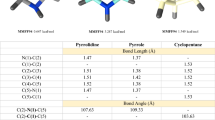Abstract
The synthesis and acid-catalyzed rearrangement of novel thiazolomorphinandienes have been presented. An isomerization was observed simultaneously with the backbone transformation. An extensive study was performed to determine the major effects of the isomerization of 2′-alkyl- and aryl-substituted thiazoloapocodeines into 3′-alkyl- and arylisothiazoloapocodeines. The obtained results provided another practical example of the reversible benzisothiazole–benzothiazole-type isomerization emphasizing the determining role of the thermal effects in the occurrence of these isomerization products. The obtained experimental results and the proposed mechanism were in agreement with the calculated DFT data.
Graphical abstract















Similar content being viewed by others
Notes
Provided the fundamental experimental method for the study of photoisomerization. Japanese scientists applied a Riko UVL-100HP (100 W) high-pressure mercury vapour lamp operated at wavelengths between 180 and 420 nm with a peak at 366 nm. Duration of the irradiation was 42 h. It means a total of 4,200 Wh of irradiation. In our photoisomerization studies the same quantity of irradiation was used.
Applied media are commonly used in the pharmaceutical industry for dissolution tests, and their quality is in agreement with pharmaceutical requirements: pH = 1.2—0.1 N hydrochloride solution. pH = 3.0—0.05 M sodium chloride solution adjusted to pH 3.0 with hydrochloride solution. pH = 4.5, 6.8 and 7.4—0.05 M sodium dihydrogen phosphate buffer adjusted to the target pH with sodium hydroxide solution. pH = 10.0—0.05 M ammonium chloride solution adjusted to pH 10.0 with ammonia solution.
The model for thebaine (1) obtained at the B3LYP/6-31G* level was very much in accord with X-ray data (ref.: Mahler CH, Stevens ED, Tundell M-L, Nolan SP (1996) Acta Crystallogr C 52:3193) for compound 1. All computations were performed using a dual-core Intel Xeon 5130 processor at 2.0 GHz. The CPU times for the geometry optimization steps were in the range of 4,812–7,332 s. The total time for geometry steps was 321 h.
See Footnote 2.
See Footnote 1.
References
Catteau JP, Lablache-Combier A, Pollet A (1969) J Chem Soc D 1018
Vernin G, Poite J-C, Metzger J, Aune J-P, Dou HJM (1971) Bull Soc Chim Fr 1103
Vernin G, Jauffred R, Ricard C, Dou HJM, Metzger J (1972) J Chem Soc Perkin Trans 2 1145
Maeda M, Kojima M (1973) Tetrahedron Lett 14:3523
Pavlik JK, Pandit CR, Samuel CJ, Day AC (1992) J Org Chem 58:3407
Pavlik JW, Tongcharoensirikul P, Bird NP, Day AC, Barltrop JA (1994) J Am Chem Soc 116:2292
D’Auria M (2002) Tetrahedron 58:8037
D’Auria M (1998) Targets Heterocycl Syst 2:233
Pavlik JW, Tongcharoensirikul P, French KM (1998) J Org Chem 63:559
Zlotin SG, Bobrov AV, Chunikhin KS (1999) Russ Chem Bull 48:1339
Pavlik JW, Tongcharoensirikul P (2000) J Org Chem 65:3626
Zlotin SG, Bobrov AV (2000) Russ Chem Bull 49:956
Sharp RT, Leeman KR, Bryant DE, Horan GJ (2003) Tetrahedron Lett 44:1559
Gilchrist TL (1985) Heterocyclic chemistry. Longman Scientefic & Technical Publishers, UK, p 214
Tóth M, Gyulai Zs, Berényi S, Sipos A (2007) Lett Org Chem 4:539
Conroy H (1955) J Am Chem Soc 77:5960
Berényi S, Hosztafi S, Makleit S, Szeifert I (1982) Acta Chim Acad Sci Hung 110:363
Berényi S, Makleit S, Rantal F (1985) Acta Chim Acad Sci Hung 120:201
Csutorás Cs, Berényi S, Makleit S (1996) Synth Commun 26:2251
Maeda M, Kojima M (1978) J Chem Soc Perkin Trans 1 685
Frisch MJ, Trucks GW, Schlegel HB, Scuseria GE, Robb MA, Cheeseman JR, Zakrzewski VG, Montgomery JA Jr., Stratmann RE, Burant JC, Dapprich S, Millam JM, Daniels AD, Kudin KN, Strain MC, Farkas O, Tomasi J, Barone V, Cossi M, Cammi R, Mennucci B, Pomelli C, Adamo C, Clifford S, Ochterski J, Petersson GA, Ayala PY, Cui Q, Morokuma K, Malick DK, Rabuck AD, Raghavachari K, Foresman JB, Cioslowski J, Ortiz JV, Stefanov BB, Liu G, Liashenko A, Piskorz P, Komaromi I, Gomperts R, Martin RL, Fox DJ, Keith T, Al-Laham MA, Peng CY, Nanayakkara A, Gonzalez C, Challacombe M, Gill PMW, Johnson B, Chen W, Wong MW, Andres JL, Gonzalez C, Head-Gordon M, Replogle ES, Pople JA (1998) Gaussian 98, Revision A.3, Gaussian, Pittsburgh
Becke AD (1993) J Chem Phys 98:5648
Becke AD (1998) Phys Rev A 38:3098
Lee WY, Parr RG (1980) Phys Rev B 37:785
Vosko SH, Wilk L, Nusair M (1980) Can J Phys 58:1200
McIver JW, Komornicki AK J Am Chem Soc 94: 2625
González C, Schlegel HB (1989) J Chem Phys 90:2154
González C, Schlegel HB (1990) J Phys Chem 94:5523
Fukui K (1981) Acc Chem Res 14:363
Acknowledgments
The authors are grateful to Prof. Sándor Antus for substantial discussions and to the National Science Foundation (Grant OTKA reg. No. T049436 and NI61336) for the financial support. We thank the Péter Pázmány Programme (NKTH, RET006/2004) for allowing us to use the microwave reactor and to Szabolcs Fekete for the valuable technical help.
Author information
Authors and Affiliations
Corresponding author
Rights and permissions
About this article
Cite this article
Sipos, A., Berényi, S. Formation of novel 1,3-thiazole- and 1,2-thiazole-fused aporphines and study on the simultaneously occurring benzothiazole–benzisothiazole-type isomerization. Monatsh Chem 140, 387–396 (2009). https://doi.org/10.1007/s00706-008-0038-x
Received:
Accepted:
Published:
Issue Date:
DOI: https://doi.org/10.1007/s00706-008-0038-x




